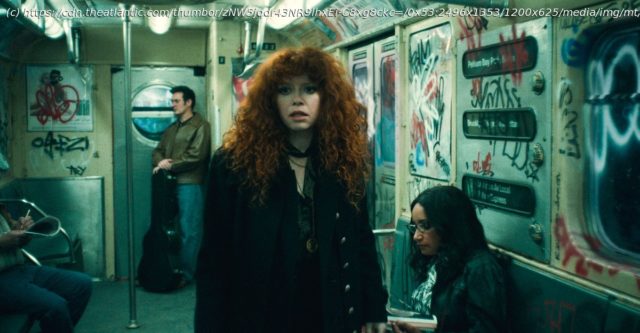The show’s second season is more audacious, but also harder to bear.
This article contains spoilers through the second season of Russian Doll. In a much-discussed essay for The New Yorker late last year, the critic Parul Sehgal analyzed the recent ubiquity of the trauma plot; the reliance, in books and on television, on stories that define characters by their pain, their guilt, the weight of their suffering. Trauma narratives, Sehgal wrote, are limited by their need to portray what trauma does: “annihilate the self, freeze the imagination, force stasis and repetition.” None of this was true of the first season of Russian Doll, a fascinating and mind-bending series about a woman stuck in a time loop, dying over and over on her 36th birthday. Yes, Nadia (played with raspy old-man panache by the show’s co-creator Natasha Lyonne) was entrenched in a recurring cycle, but each trip toward death was equally puzzling and revealing. The show’s revelation that she wasn’t alone in her time loop blew up the parameters of the story and led to a conclusion that was affirming, even celebratory. No one, Russian Doll seemed to be saying, can truly survive alone, or without attending to others. Season 2, which debuted on Netflix this week, is somehow even more ambitious, even denser with layers (“I don’t think you want to peel that onion,” Nadia tells a man in one scene who asks her who she is), allusions, and belly flops right into the temporal paradox. Instead of being trapped within loops of time, Nadia finds herself vaulting back into the past, via a mystical subway that sends her into the bodies of her mother and grandmother. The show’s examination of inherited trauma—Nadia’s grandparents, like Lyonne’s, were Holocaust survivors—through the Back to the Future –esque conceit of time travel seems ripe with potential. But as the season unfurls, it’s also raw, bruising, and existentially heavier than its predecessor. If the first installment felt miraculously complete, the seven new episodes feel instead like a slide down into a darker space. They end (abundant spoilers from this point on) with Nadia realizing she’s left the only person who ever meaningfully cared for her to die alone. The final scene—in which she pulls heavily on a joint at the wake of her beloved “aunt” Ruth and smiles wanly into the mirror where she kept finding herself alive during Season 1—feels static, even cruel. Trying to escape a legacy of guilt and pain, which are banded with drugs and alcohol into one trippy mille-feuille, Nadia only loads herself up with more of both. The questions the new season seems to ask are: What do you do when so much of your fate seems to have been determined by forces you can’t control? How much historical trauma can one person bear? Focusing on this immensely weighted subject is Lyonne’s prerogative, and it’s a bold choice for an artist to make. (It’s fair to say that Nadia is a non-sober version of Lyonne, whose childhood was similarly turbulent and unstable.






